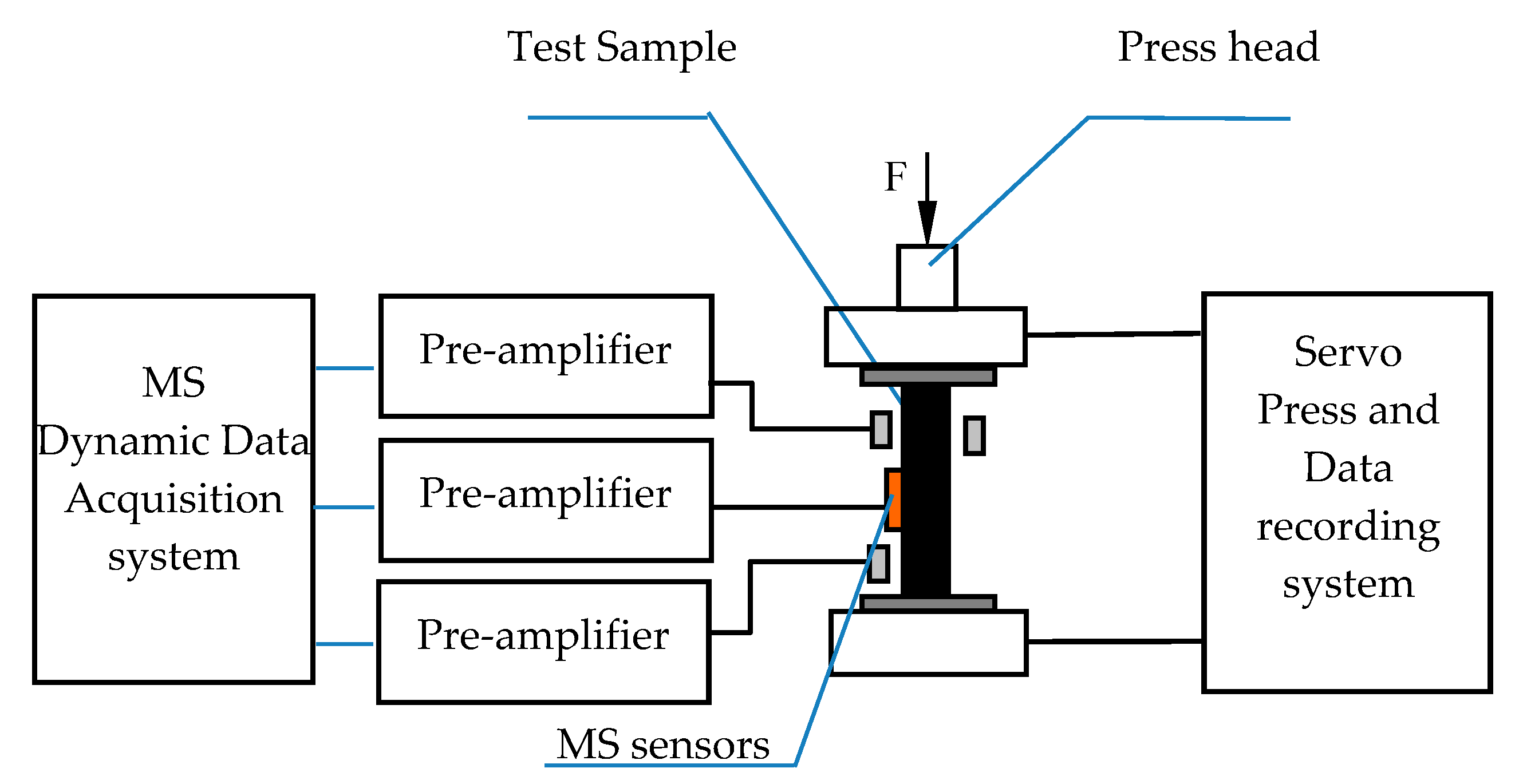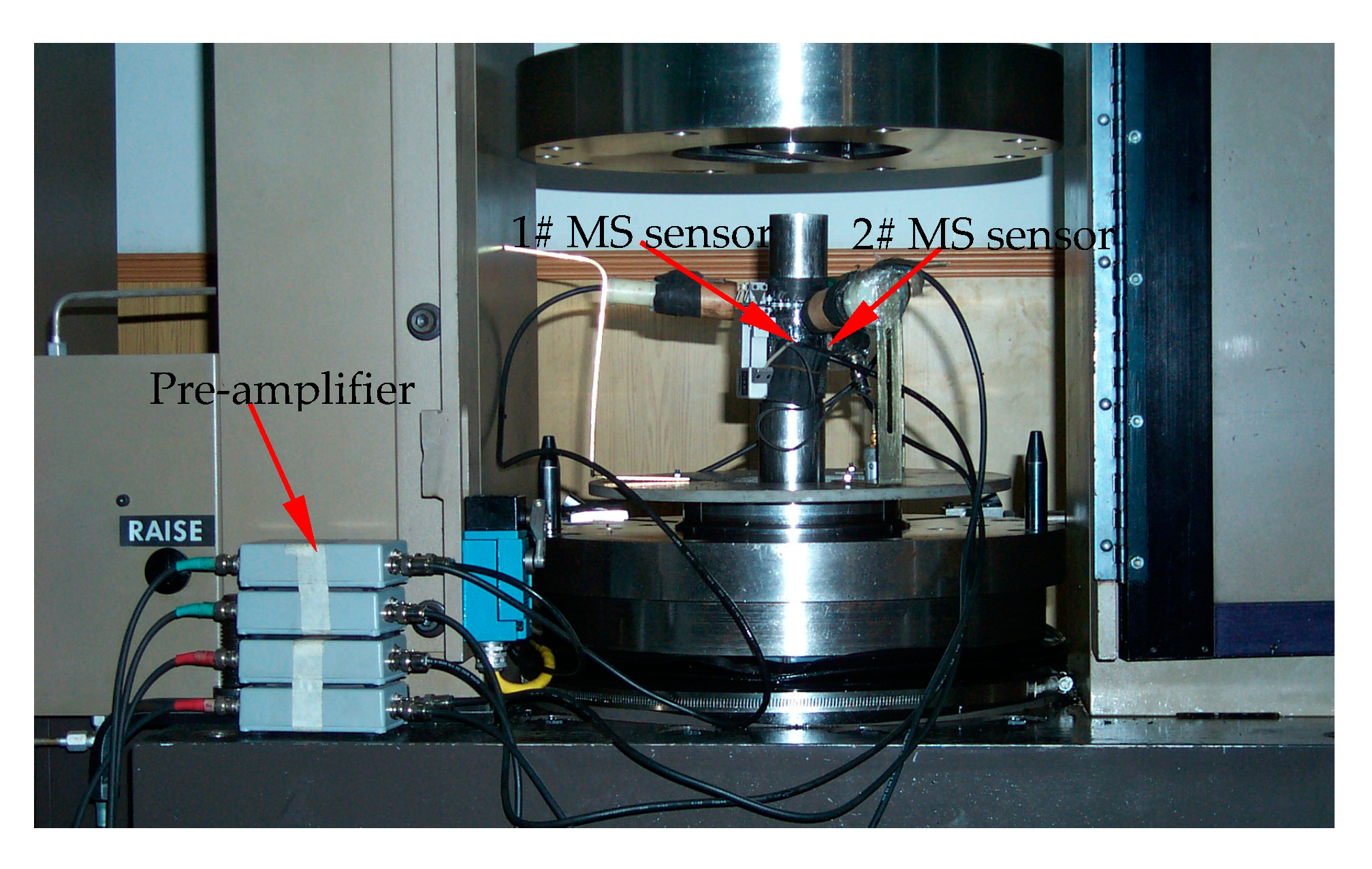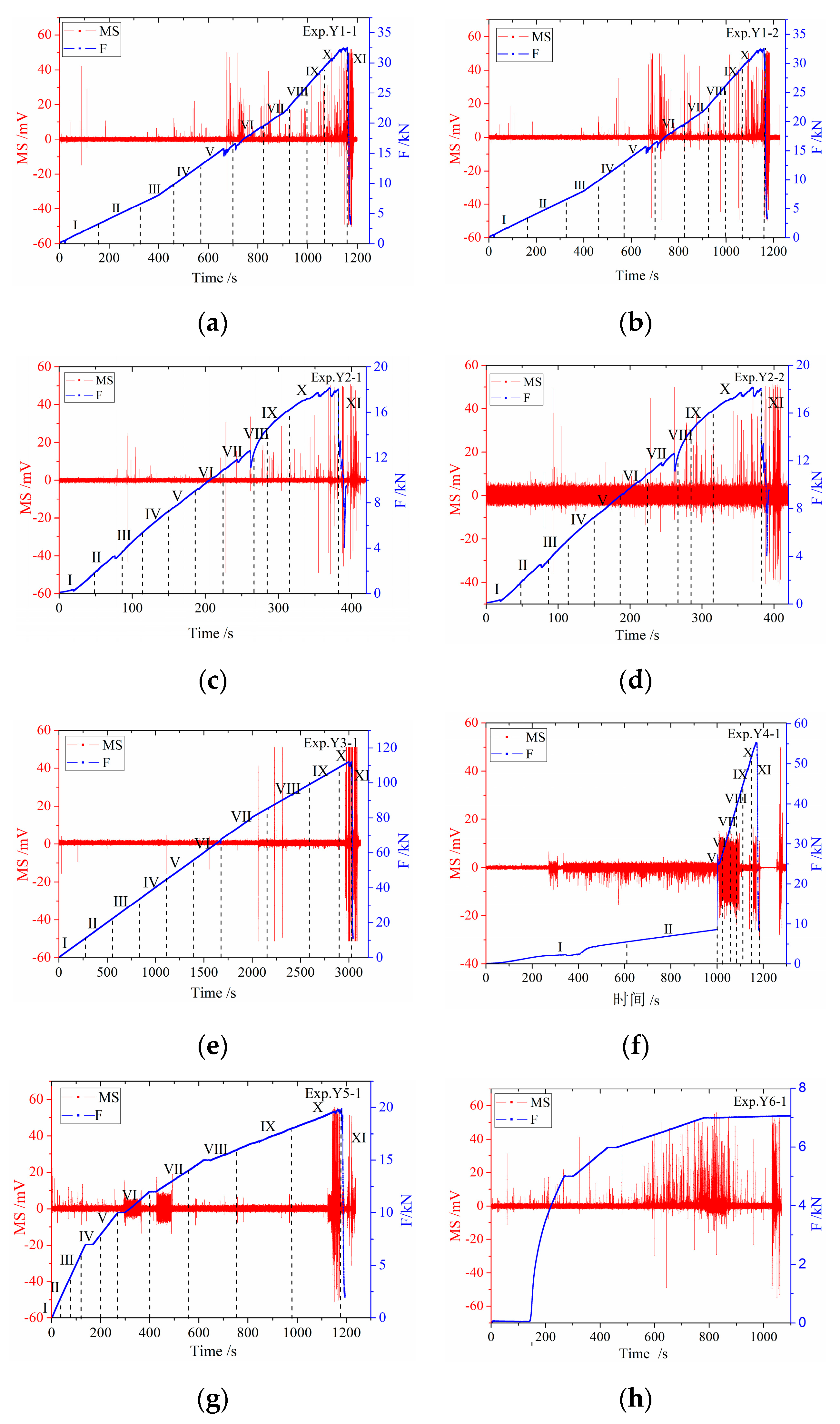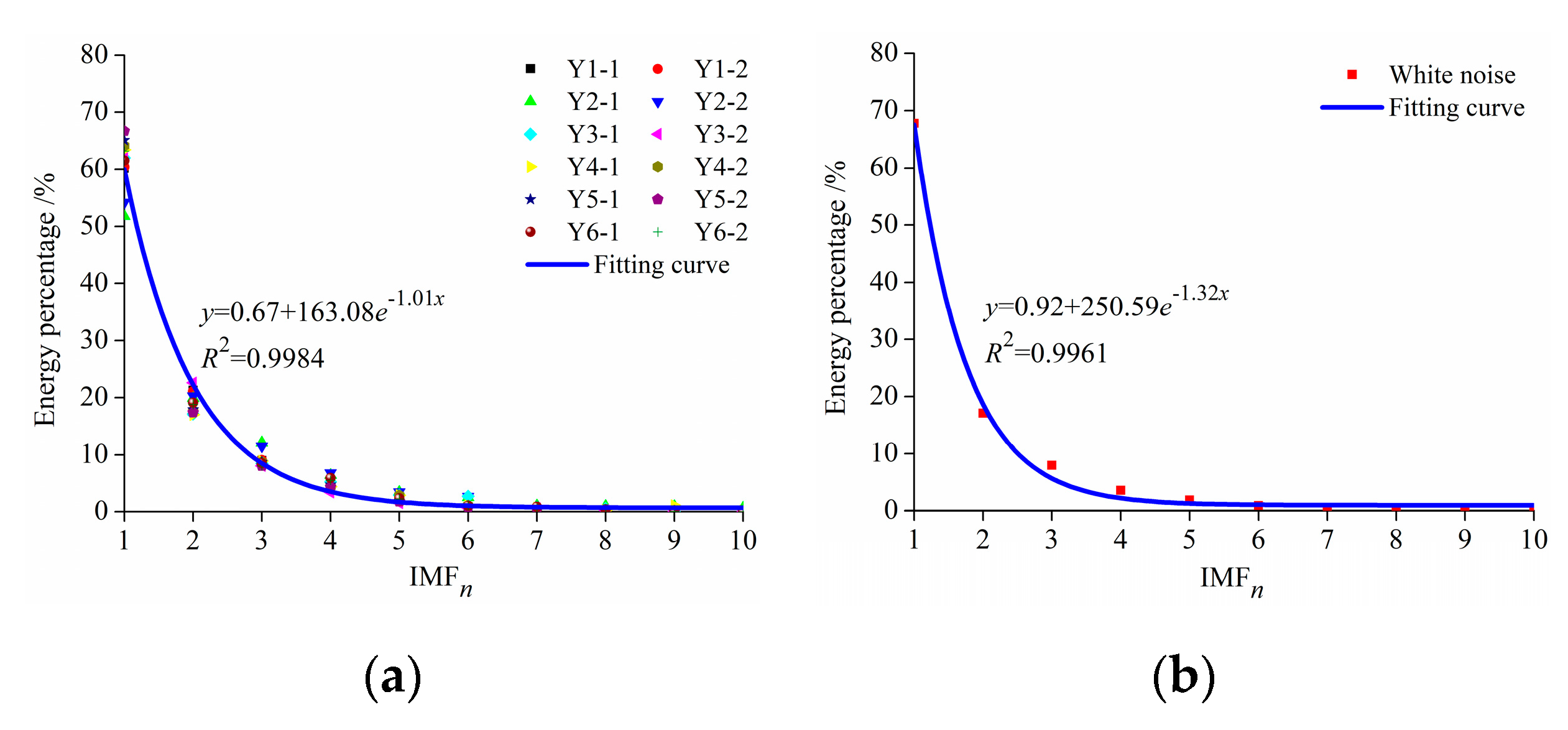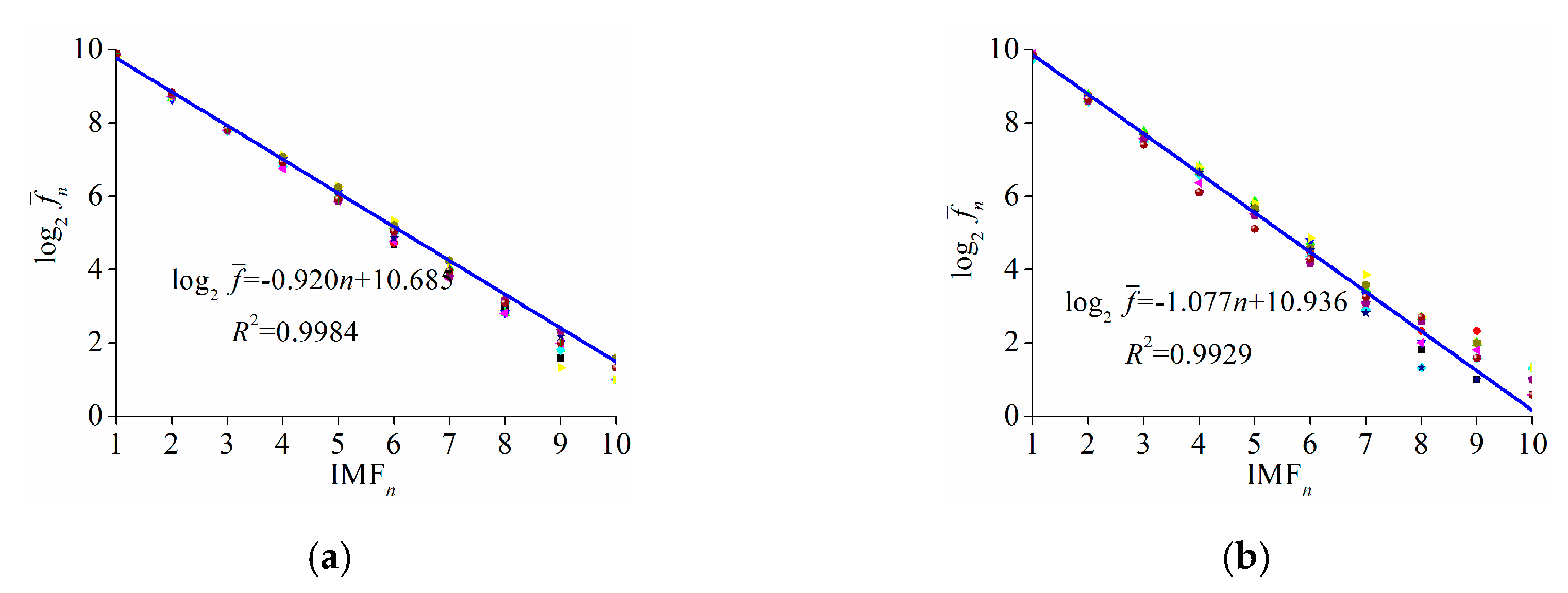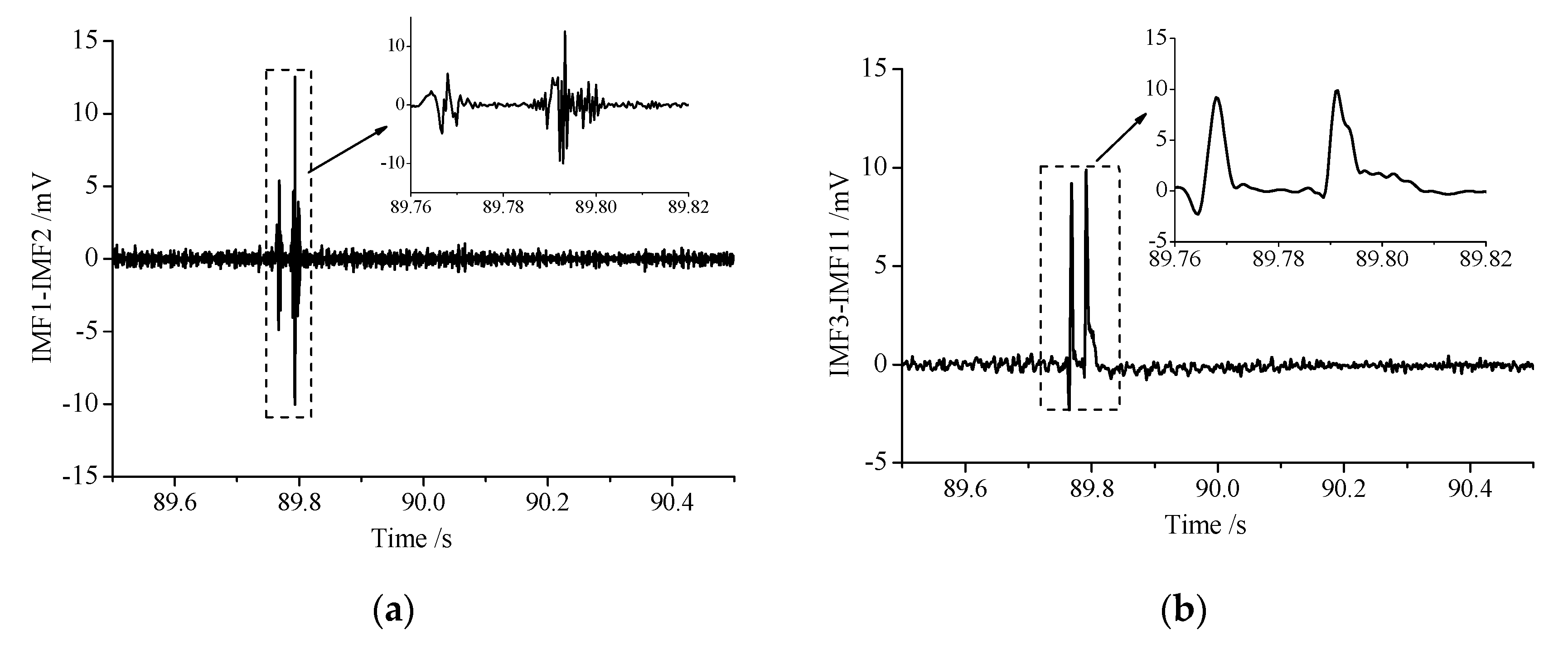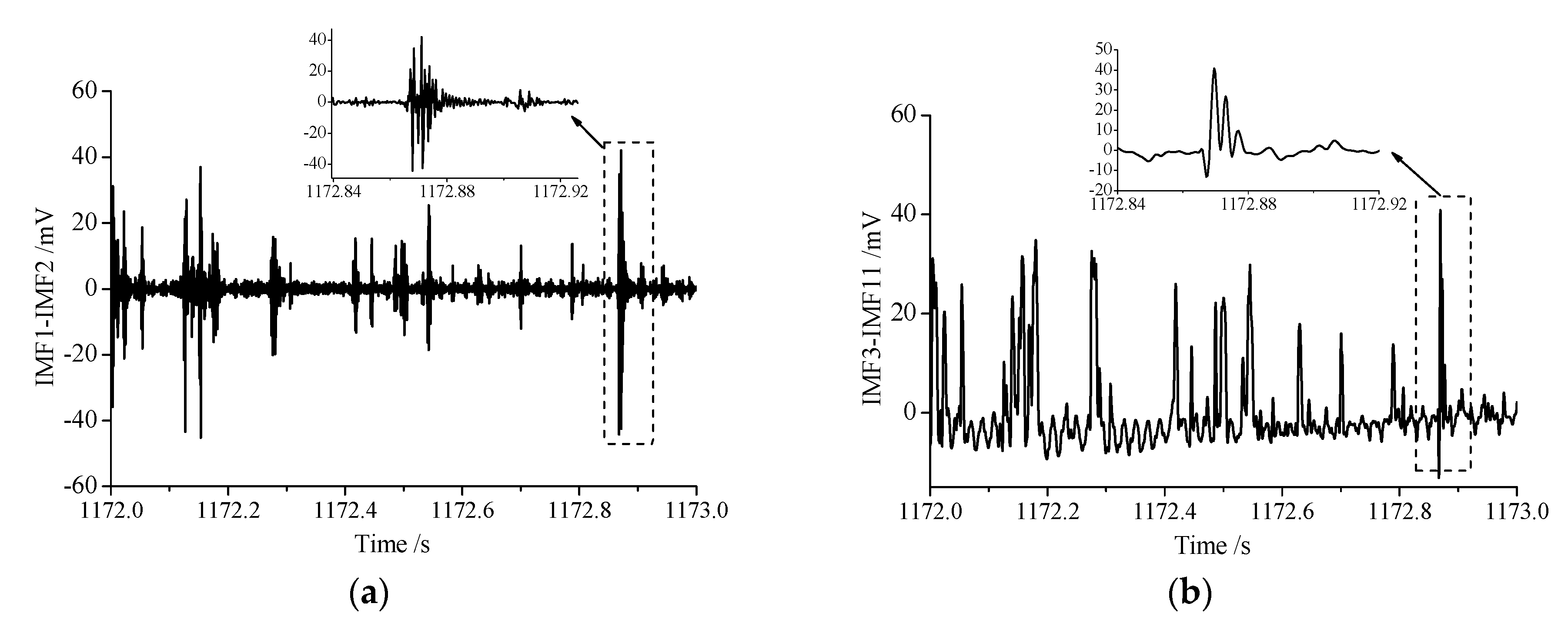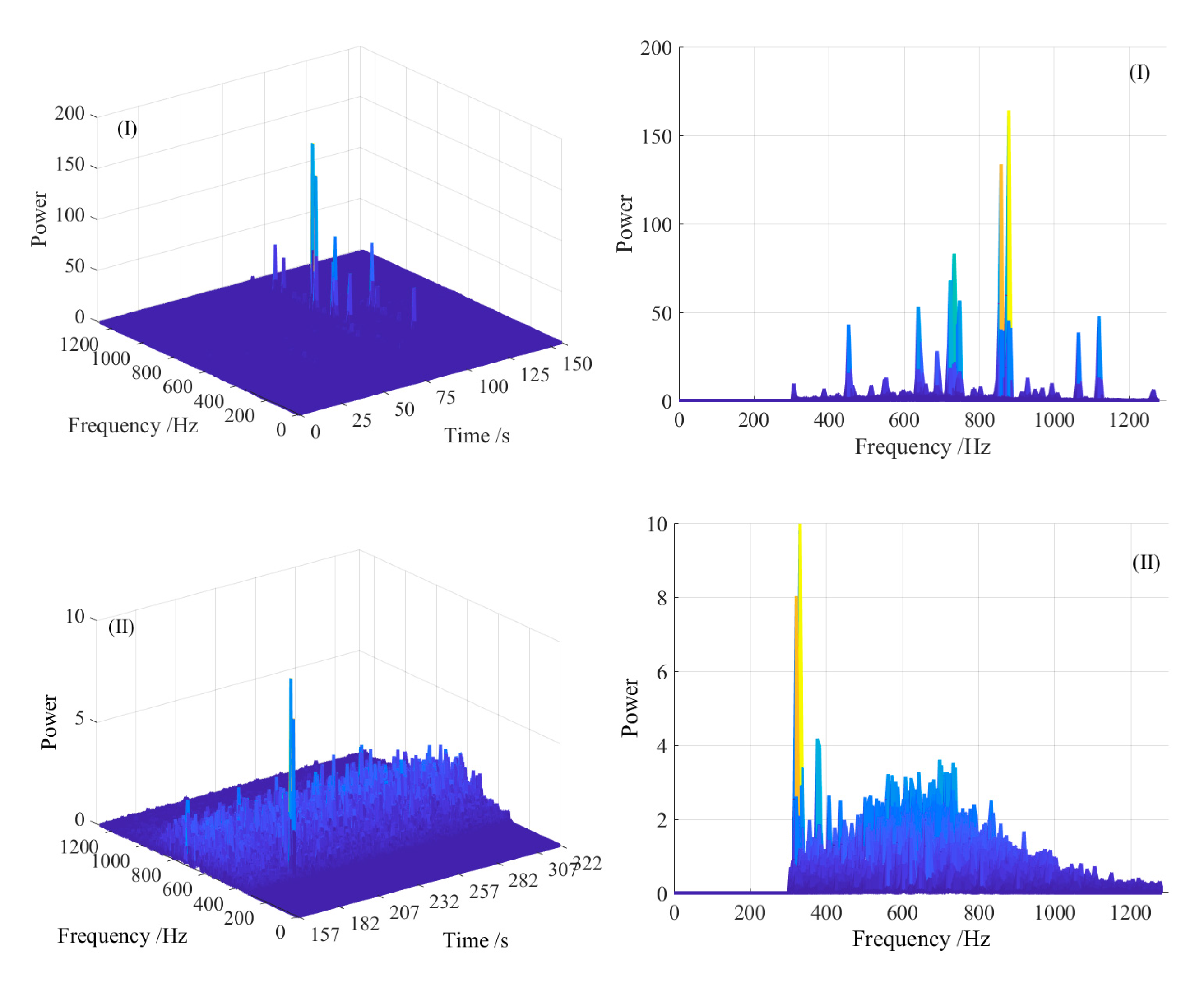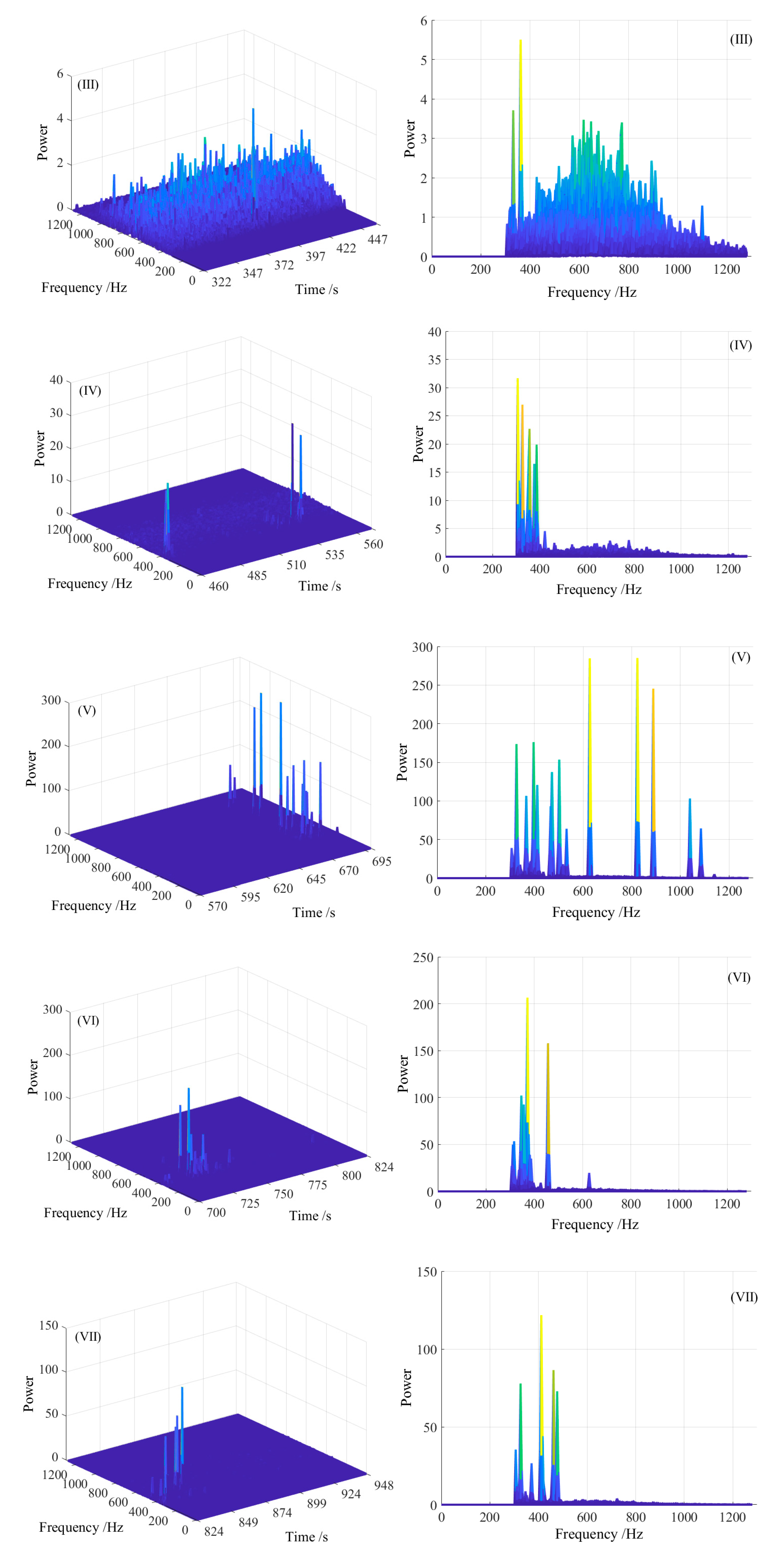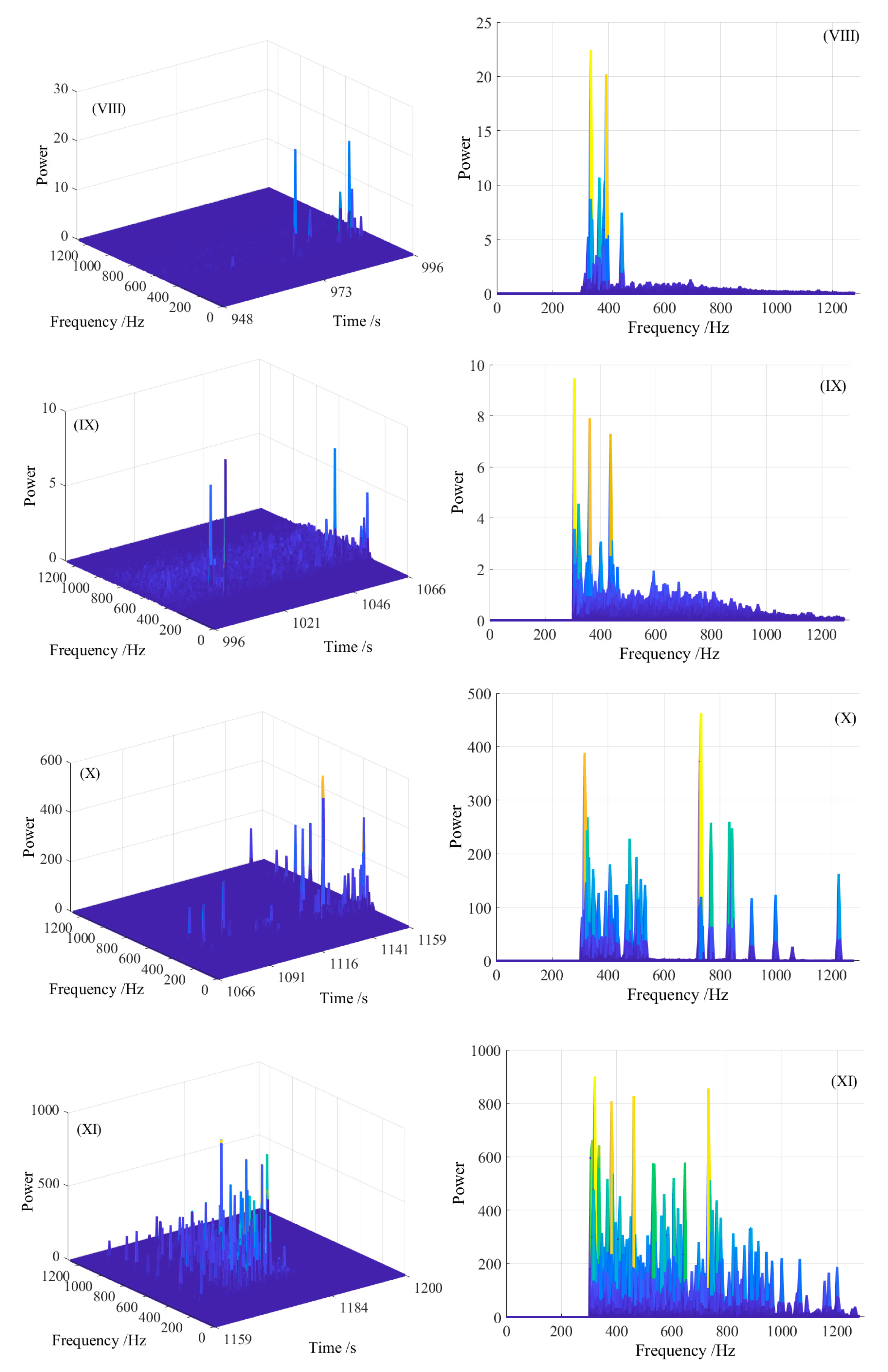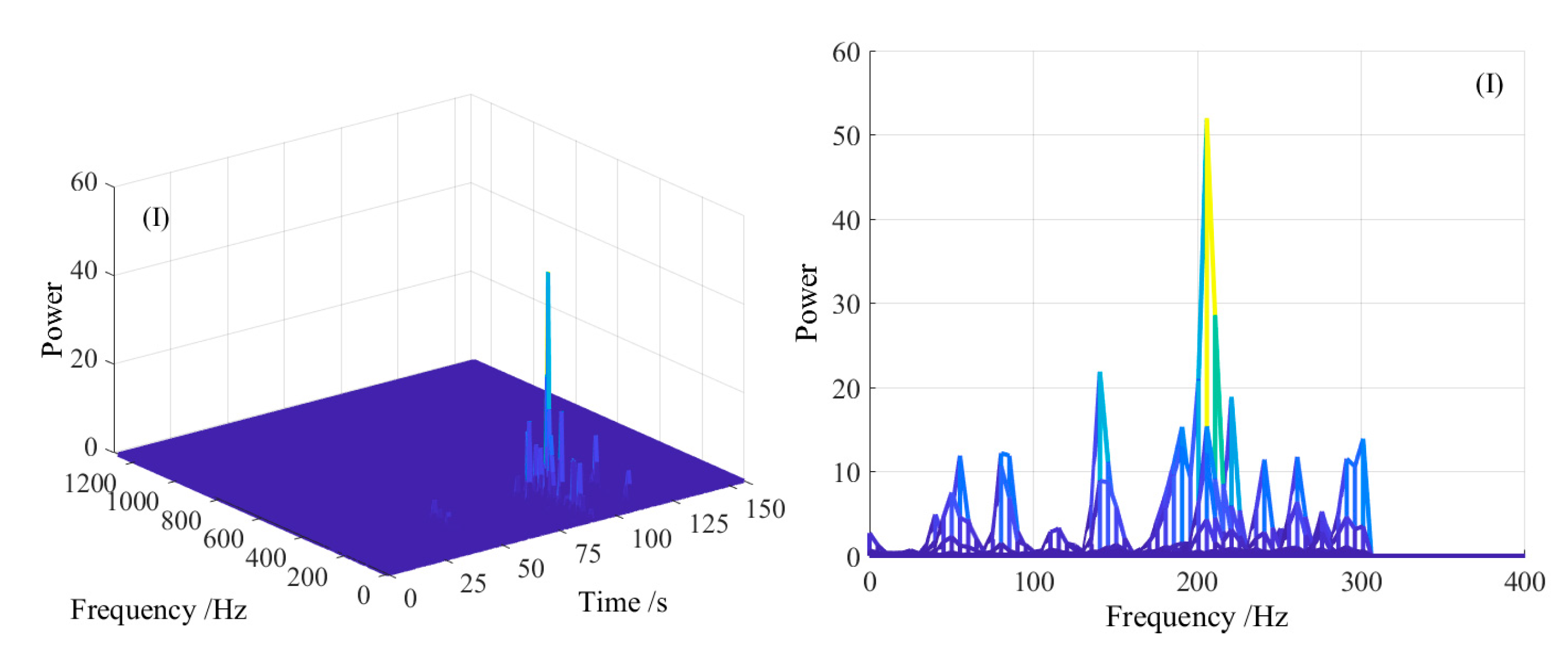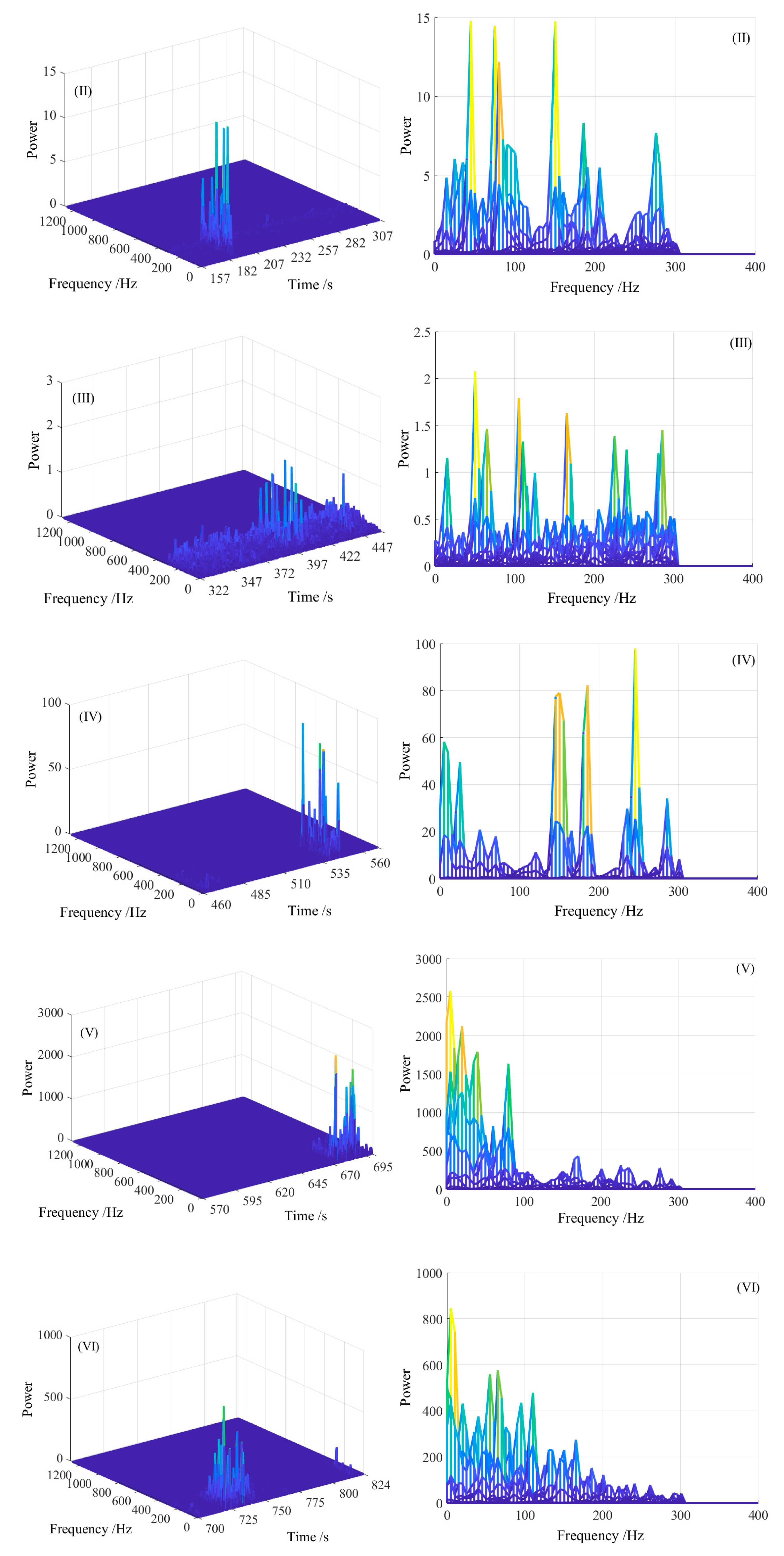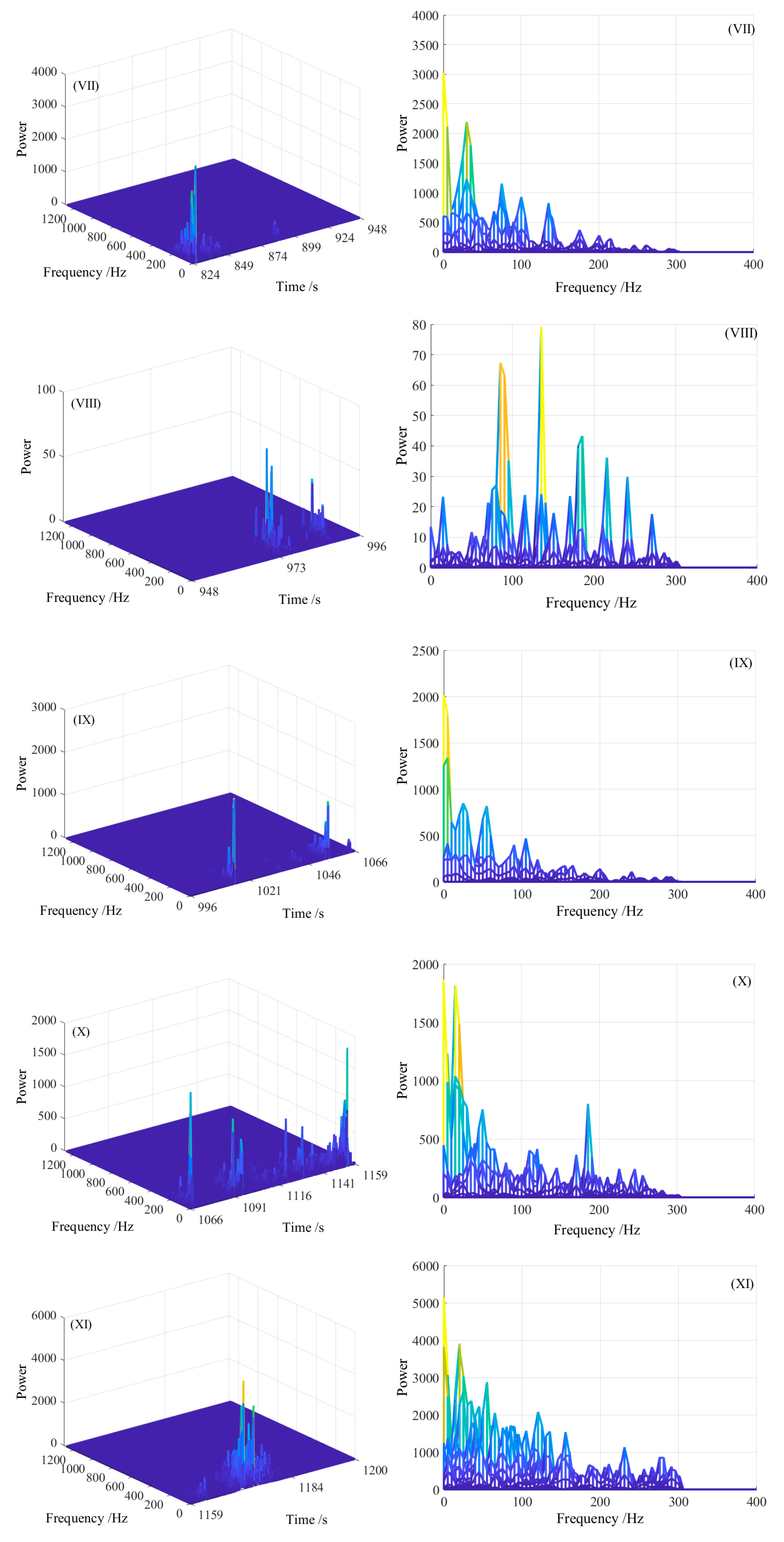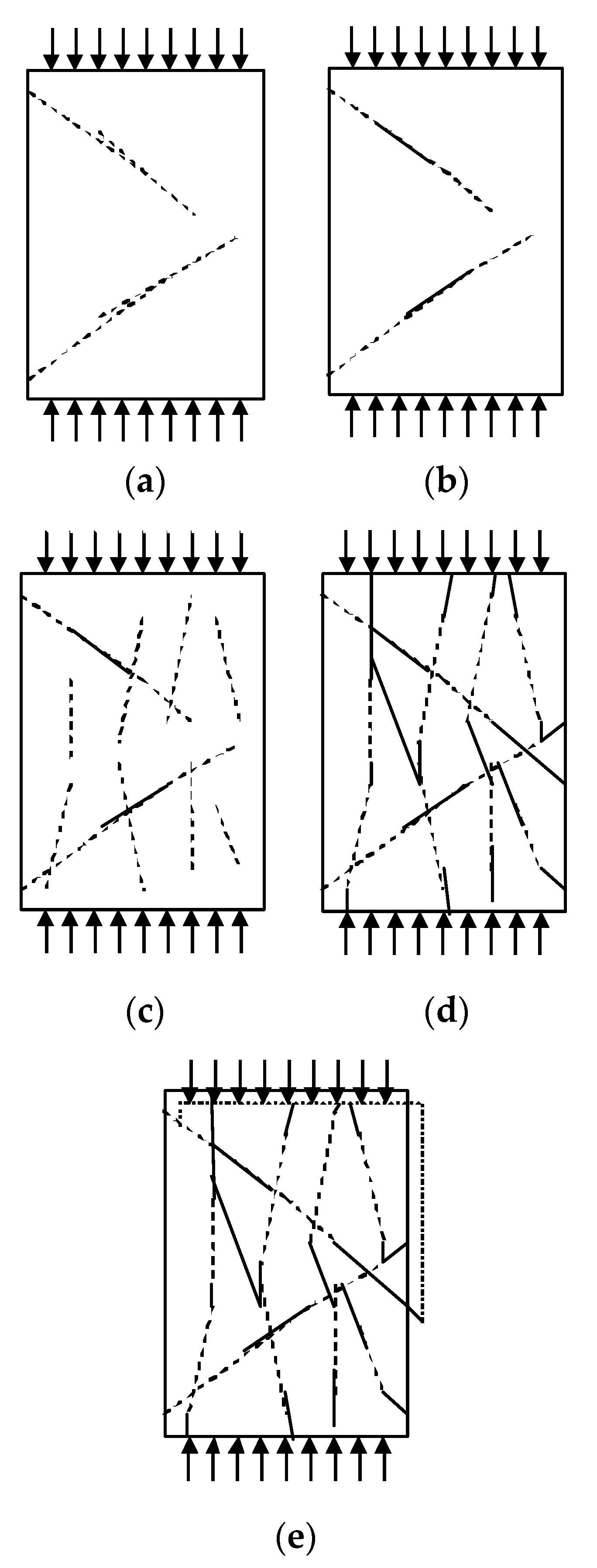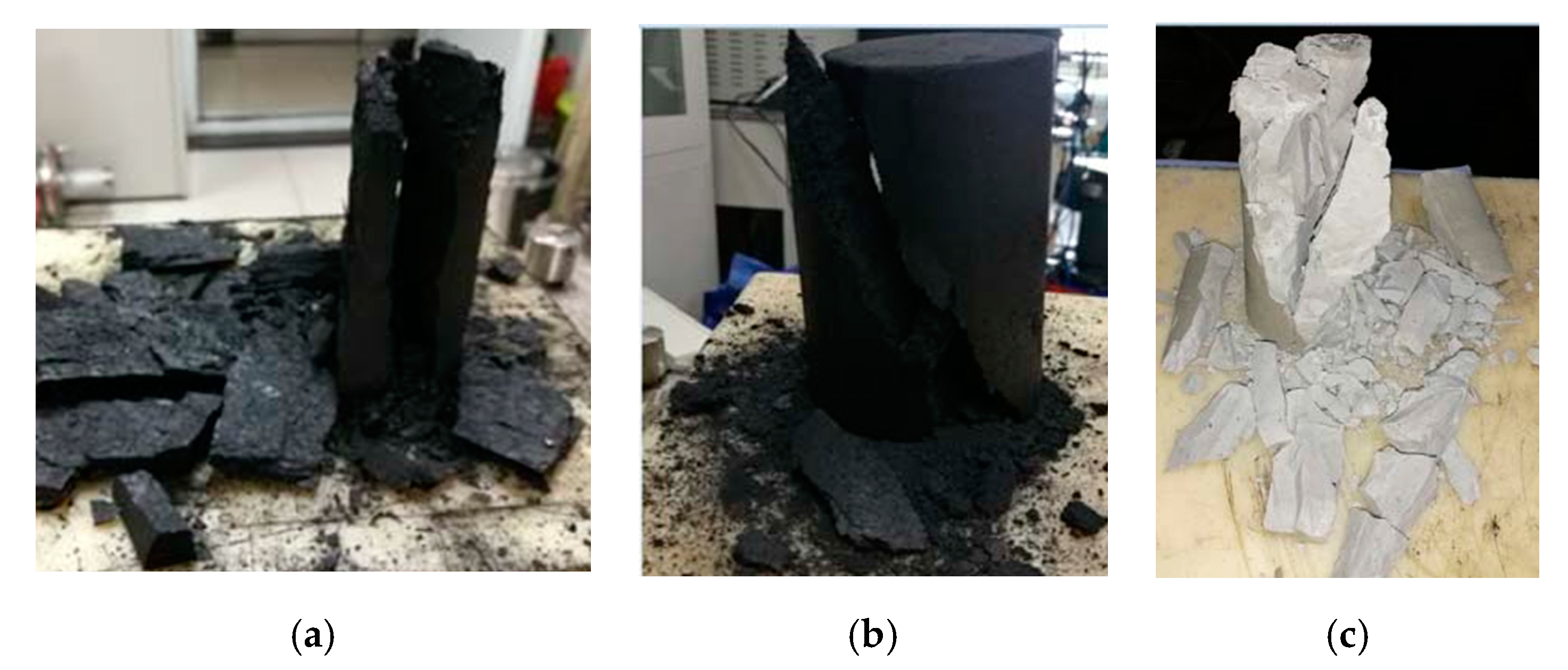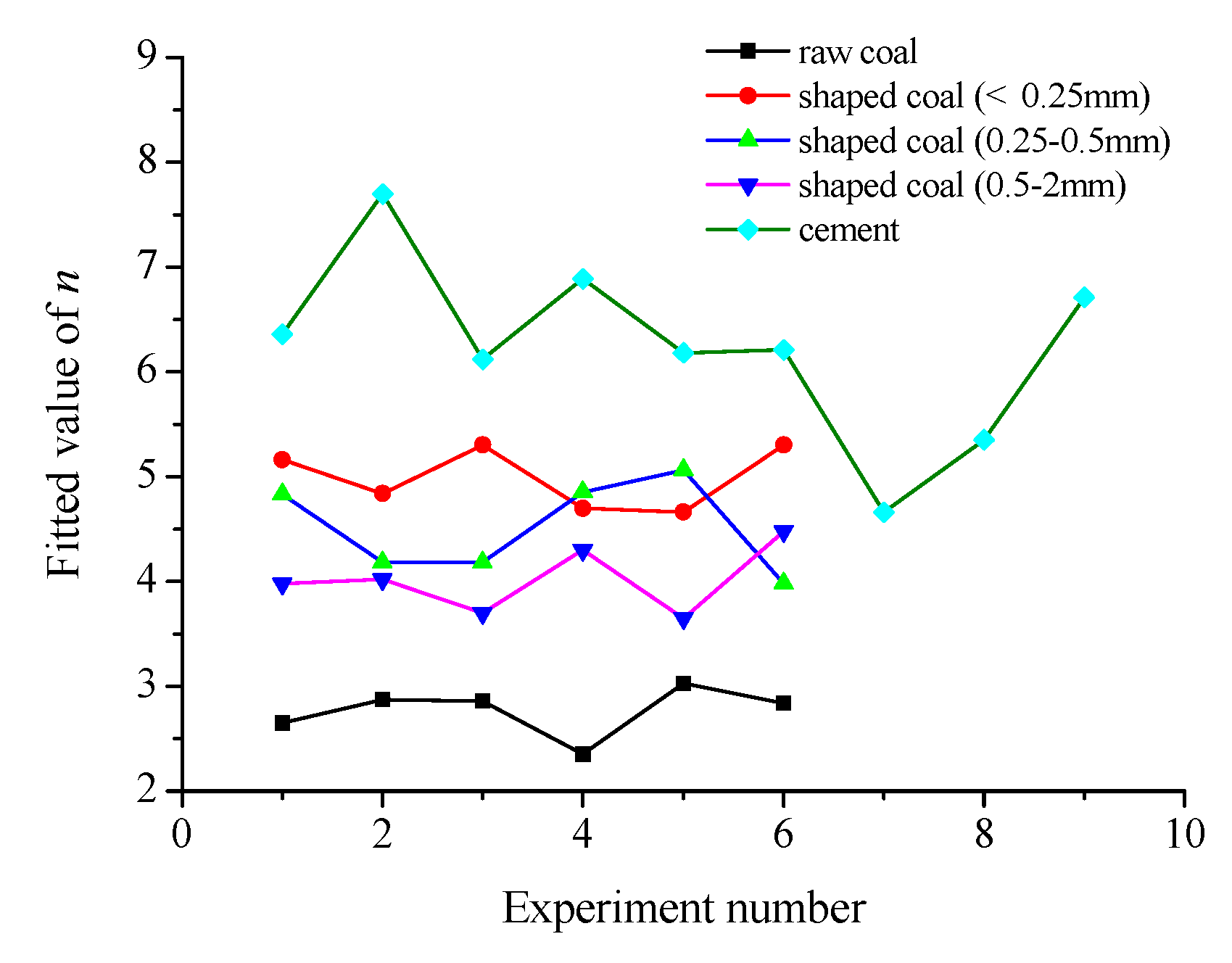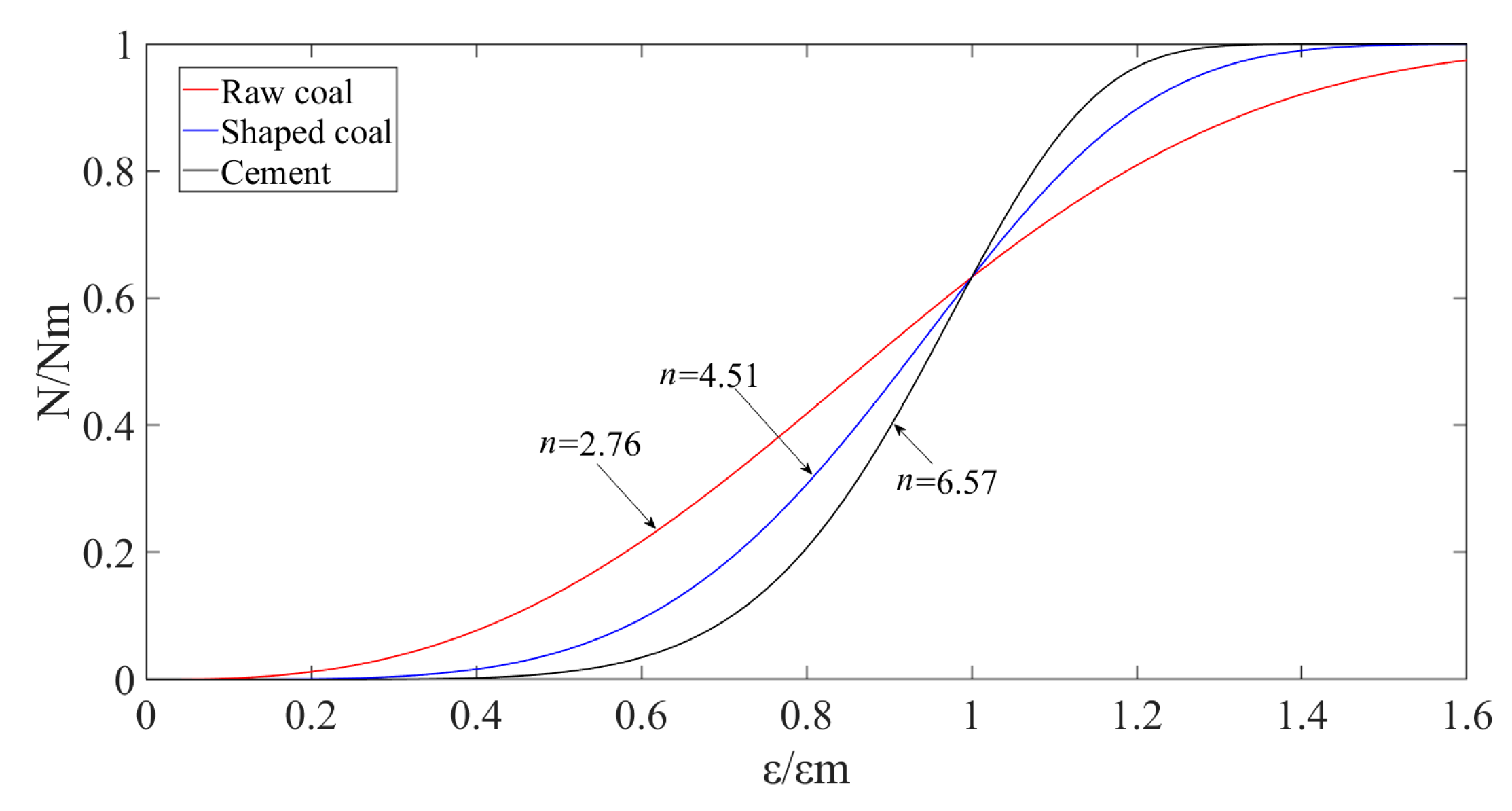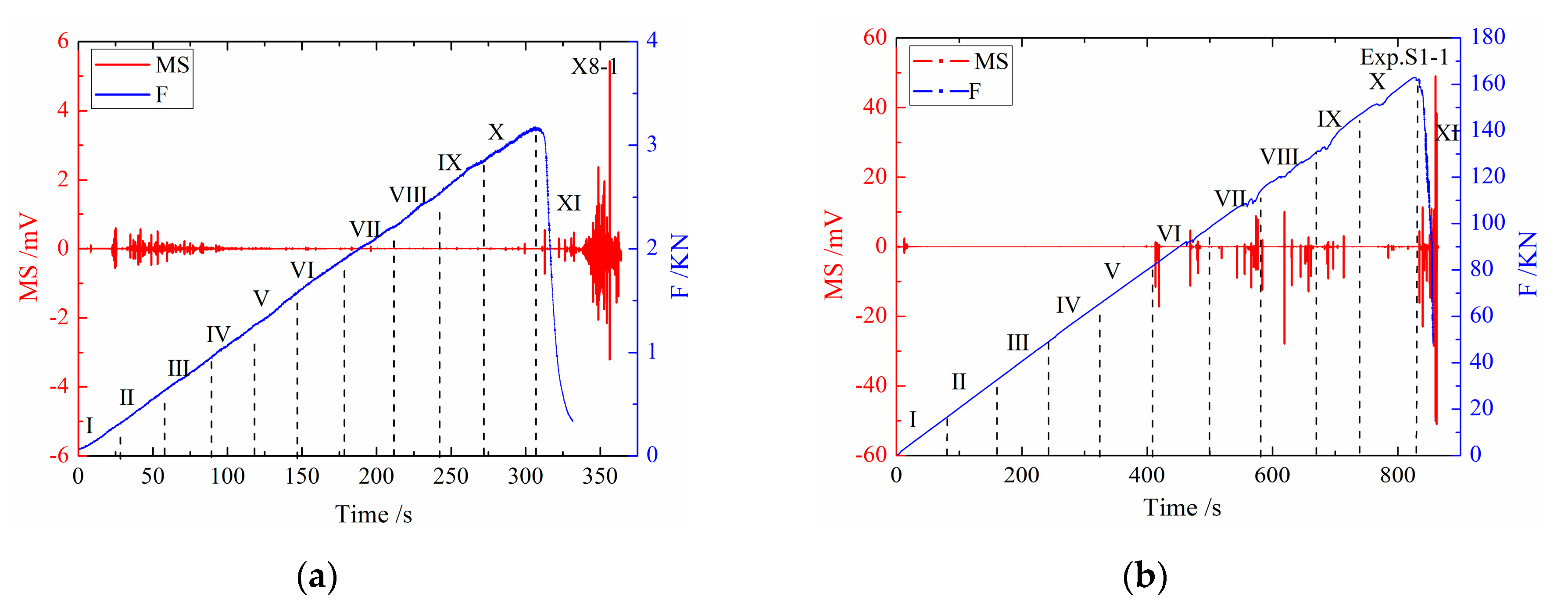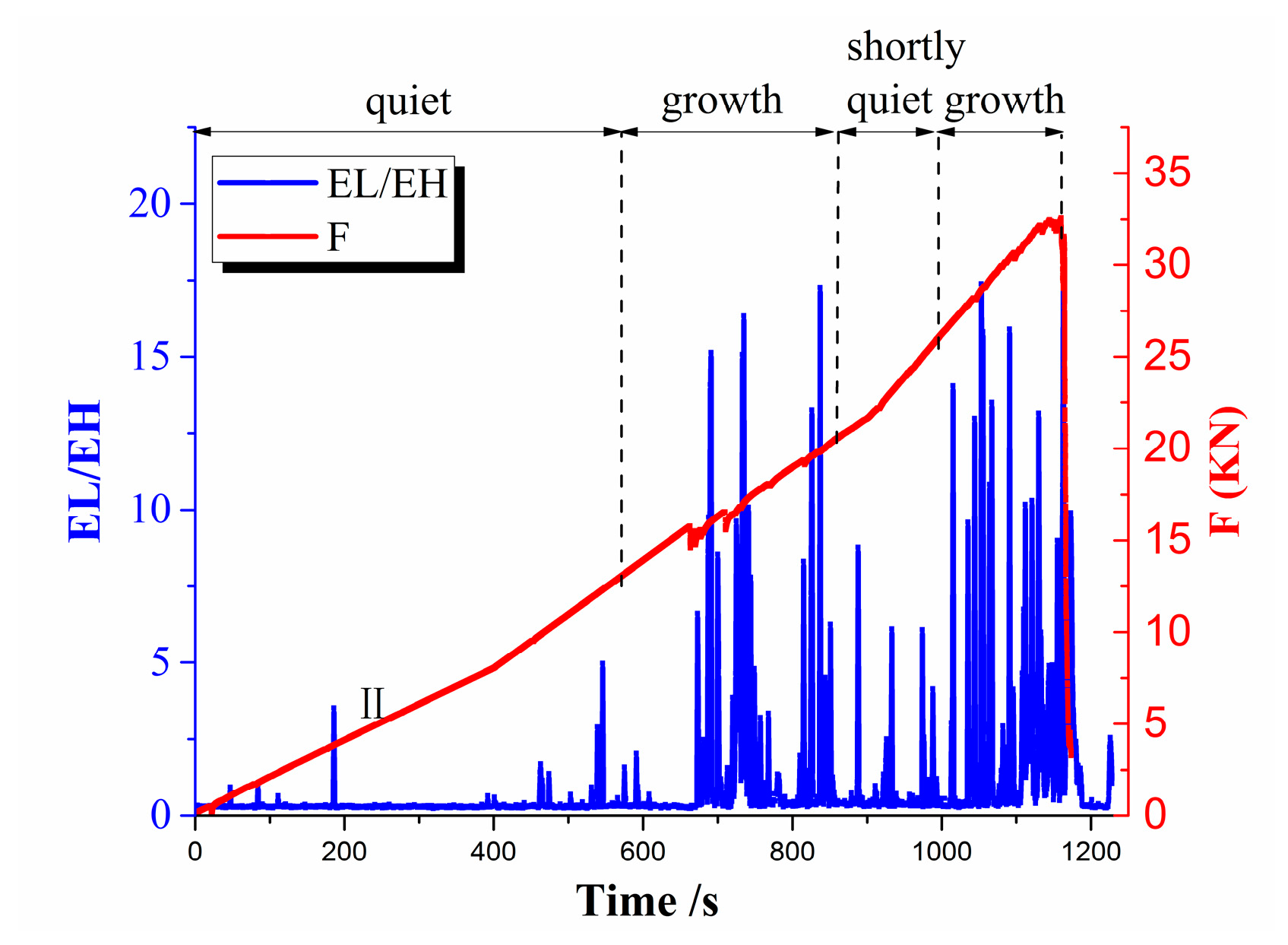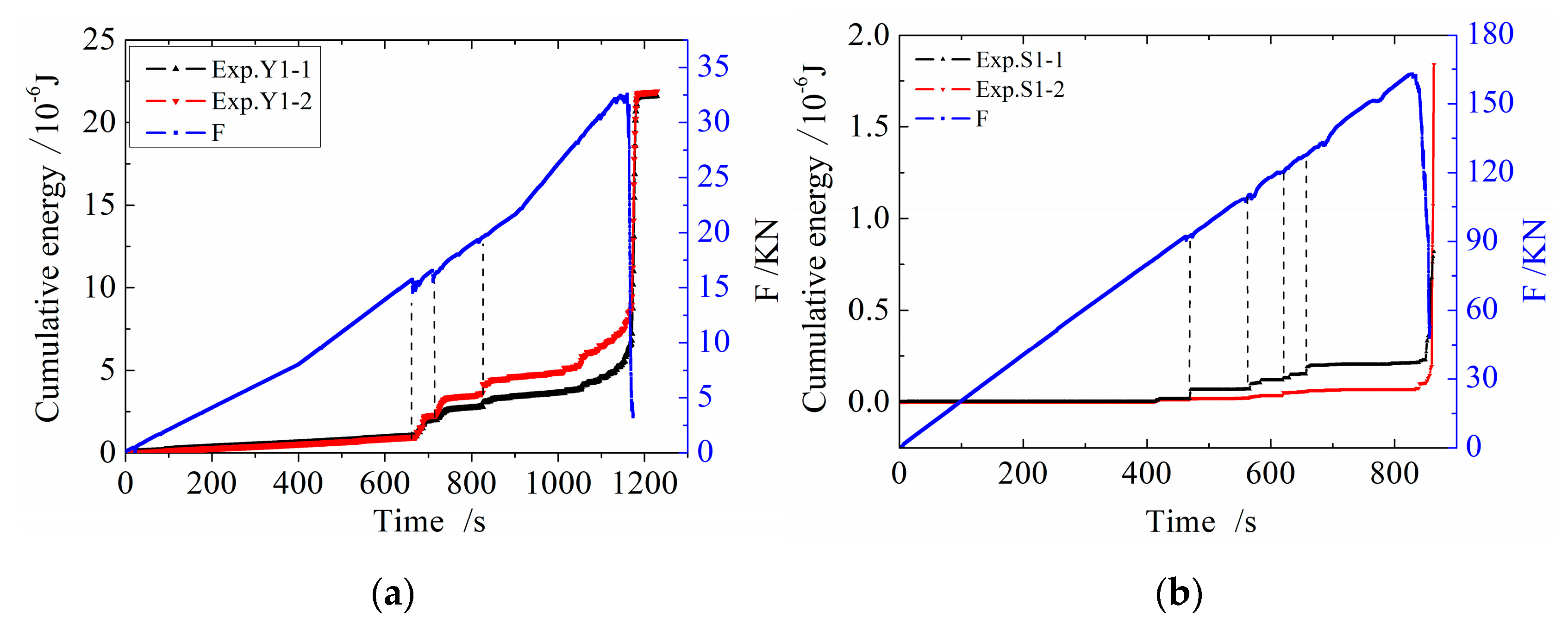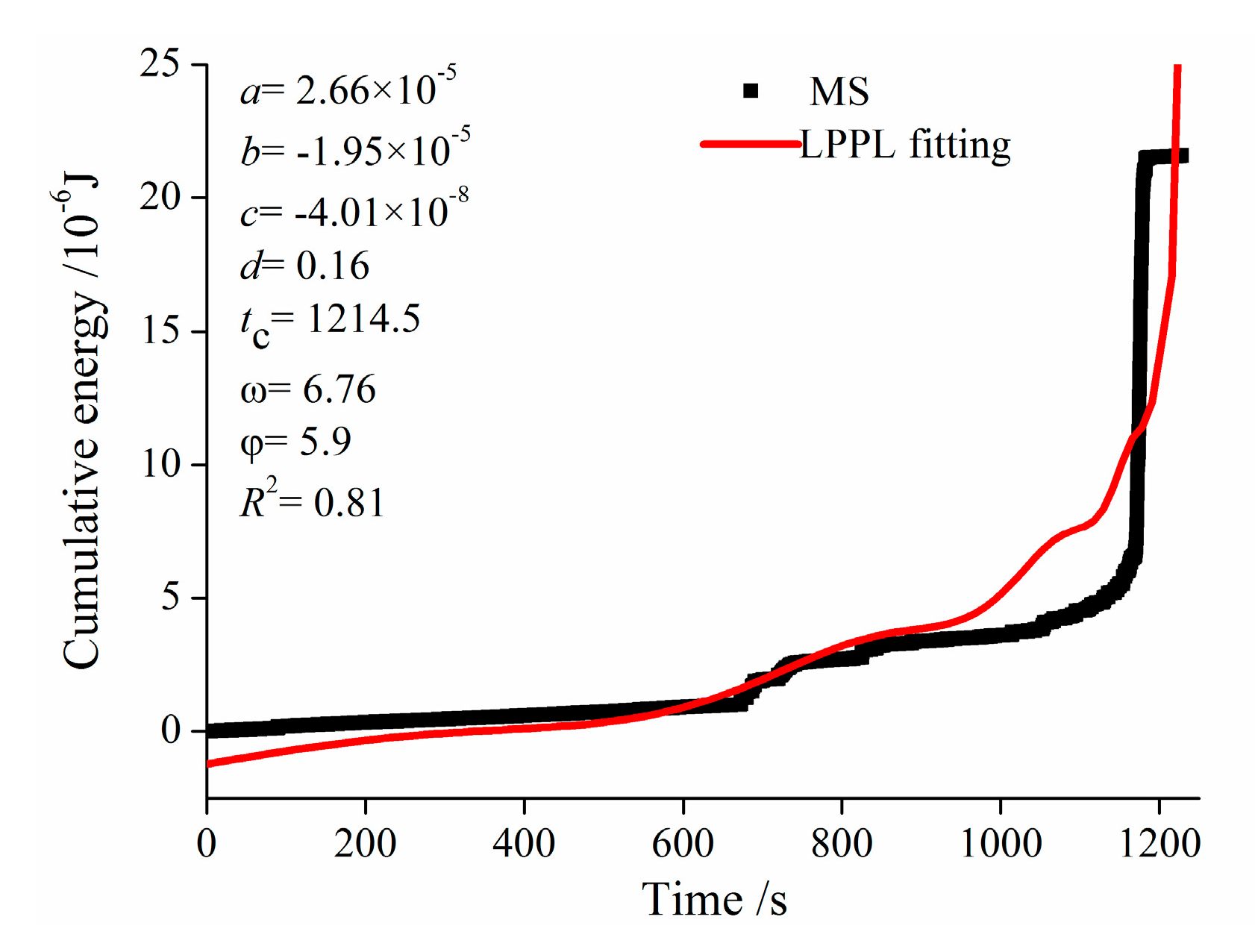1. Introduction
Although many countries and regions in the world have reduced the use of coal, some countries, e.g., China, India and South Africa, remain heavily dependent on coal resources. Coal consumption still accounts for a large proportion in the energy consumption structure in these countries. With the depletion of shallow coal resources, especially in China, mining depth of a coal mine increases sharply, and high ground stress, high ground temperature, hyperosmosis and strong disturbance problems are gradually emerging. In the complex environment, coal and rock materials are under long-term high loading condition, and internal damage degree is more serious compared to shallow mining. The normal mining disturbance is also easy to induce the deformation and fracture of coal or rock materials and then cause serious hazards, such as rock burst, coal and gas outburst and large deformation of surrounding rock [
1,
2]. Influenced by environmental protection and policy orientation, the proportion of oil, natural gas and new energy in the disposable energy structure has increased. The study on the damage of coal and rock in the development of these resources should also be getting enough concern. The reason is that in the process of shale gas or natural gas exploitation and gas extraction, hydraulic fracturing is often used to cause deformation and failure of coal and rock mass, so as to increase the permeability of coal and rock mass to achieve high production. Thus, the damage degree of coal and rock mass directly affects the production of oil and gas wells. Meanwhile, with the expanding excavation of underground cavern and tunnel of hydropower station, underground storage cavern and slope, the problem about deformation and failure of surrounding rock are also becoming increasingly apparent, which has a serious impact on the construction and operation of the project. Thus, how to accurately and effectively monitor and forecast the damage evolution process of coal and rock mass, and form a set of prediction methods and indicators is an urgent engineering problem to be solved.
As a form of energy dissipation in the process of coal and rock damage, MS accompany the whole process of deformation and fracture of coal and rock and can reflect the internal damage evolution process of coal and rock in real time. MS monitoring technology has been widely applied to source location [
3,
4], safety design [
5], prediction and early warning of disasters [
6,
7], etc. in mine, tunnel cavern, diversion tunnel of hydropower station, underground storage cavern, slope excavation, etc. For example, Zhu et al. [
8], Ding et al. [
9] and Wang et al. [
10] conducted experimental investigation on the MS frequency response before the coal and rock dynamic disasters, such as coal and gas outburst, mine rock and rock burst, and found that the frequency spectrum distribution of MS varied in the damage evolution process of coal and rock and frequency spectrum law can reflect the damage degree of coal or rock to some extent. He et al. [
11] used the MS frequency index and energy index to monitor mining disturbance and geological anomaly of the coal seam and this method could realize reliable detection of distribution characteristics of static load stress field in coal seam area. Zhu et al. [
12] adopted arrival times of the MS P-phase to collect the MS signal of hydraulic fracturing of the coal seam, and then realize the fracture tracking and effect evaluation. Maity and Ciezobka [
13] discussed how b-value distribution provides insights into the rock type as well as the interaction with pad scale faults in shale reservoirs, and believed the in-situ stress state had a significant bearing on the b-value and there was a significant impact of in-situ discontinuities and rock brittleness on the microseismicity distributions. The analysis of the microseismic b-value provides a template for future applications where MS surveys are available. Chen et al. [
14] introduced an improved matching and locating technique to detect and locate MS events (4 < ML < 0) associated with the hydraulic fracturing treatment and adopted clustering behavior including b- and D-value distributions to understand shale stimulation behavior, and firstly demonstrated the detectability and location accuracy of the proposed approach with a pseudo-synthetic data set. Martínez-Garzón et al. [
15] applied state of the art seismological processing schemes to the continuous seismic waveform recordings and confirmed that MS monitoring of reservoir treatment could contribute towards improved reservoir monitoring and leakage detection. Mao et al. [
16], Ma et al. [
17] and Dai et al. [
18] used the MS monitoring technology to monitor and analyze the microfracture evolution in the surrounding rock of the cave in real time. The relationship between temporal and spatial evolution of MS and the rock burst was revealed. The results showed that MS activities generally have time priority and spatial consistency to rock burst events, which could provide a basis for rock burst prediction of tunnel and microseismic monitoring and early warnings. Xu et al. [
19] quantitatively evaluated the relationship between microseismic activities induced by rock mass damage during slope instability, strength degradation and dynamic instability of the slope are explored, and the slope stability. Then, they proposed a dynamic evaluation method of rock slope stability considering the effects of MS damage. They argued that MS activity induced by construction disturbance only slightly affects the stability of the slope. The proposed feedback analysis technique provided a method for dynamically assessing rock slope stability and could be used to assess the slope stability of other similar rock slopes. Through the above analysis, we can know that MS monitoring technology can be applied in many aspects. The main reason lies in the close relationship between the MS signal and deformation and failure of coal and rock materials. MS signals can indirectly reflect the damage of coal and rock materials, so as to realize disaster prediction or the effect evaluation of hydraulic fracturing.
In previous studies, it was confirmed that the MS parameters, such as amplitude, event number and frequency, which could reflect the quantity, size and direction of microcrack propagation, had a great relevance on damage degree of coal and rock [
20,
21,
22,
23]. The actual MS signals contain a great amount of noise whose interference often results in the difficulty of the signal processing. Therefore, accurate identification of MS is of important theoretical significance to coal damage criterion.
MS identification can be reflected directly or indirectly by the following two methods: characteristic parameter analysis and wave spectrum analysis. The former reveals MS monitoring mechanism of the source and precursors law of rock mass failure by means of statistical analysis of MS events number, event count, amplitude, b value and energy count. Especially, the distribution of event count, amplitude and energy count is consistent with energy distribution. Many researches have been devoted to the application of characteristic parameter analysis method in rock engineering. For instance, Blake et al. [
24] and Lu et al. [
25] found that there were obvious anomaly MS events counts before rock burst by monitoring MS events induced by hard rock fracture. Ma et al. [
26] and Xia et al. [
27] quantitatively studied advance support pressure distribution rule of working face by analyzing corresponding relation between MS events number and support stress. He et al. [
28] evaluated dynamic and static stress disturbance through seismic wave velocity to predict the rock burst risk. Wu et al. [
29] believed that the sudden release of accumulated strain energy in rock mass had a performance of abrupt change of cumulative number of MS events, which can be used as rock instability and failure precursor. Kwiatek et al. [
30] analyzed the b value variations over successive seismic cycles in laboratory stick-slip experiments. Chen et al. [
31] insisted that weak MS activity meant energy accumulation for strong shock, which can be used to forecast the danger of a rock burst.
Recently, there is more and more interest in the wave spectrum analysis method to acquire MS characteristics. The frequency spectrum of the MS signal is rich, and its main frequency varies from a few Hertz to several hundred Hertz. Specific damage mechanisms generate specific MS spectrum. In previous studies, the mathematical analysis method was extensively applied in to analyze the distribution of the main frequency of MS signals. Ge [
32] and Errington et al. [
33] analyzed the energy spectral density characterization of MS events in two potash mines and found that peak frequency of MS signals is approximately 38 Hz or 54 Hz. Lu et al. [
34] studied the spectrum characteristics of MS signals monitored in situ, such as coal and gas outburst, rock burst, pressure release blasting, etc., and found that before a coal and gas outburst occurred, the low-frequency component of 0–10 Hz changed significantly, and the relatively high-frequency component of 90–240 Hz increased correspondingly. However, the main frequency of the precursor signal of a rock burst was below 50 Hz, the main frequency of the coal seam pressure release blasting was below 20 Hz and the main frequency of the roof pressure relief blasting was between 10 and 150 Hz. Li et al. [
35] compared and analyzed the propagation law of MS signals between coal layers under vertical bedding and parallel bedding, and concluded that MS signals had a small attenuation along the bedding, but a large amplitude attenuation and signal delay in the direction of vertical bedding. Meanwhile the frequency spectrum of MS signals was obtained using the Hilbert–Huang Transform (HHT), and the main frequency of MS signals was between 20 and 100 Hz. Yuan [
36] obtained the spectrum characteristics and distribution change rule of MS using Fourier transform (FFT) and fractal geometry theory. However, for nonlinear and non-stationary signal, e.g., MS, it is hard to find the right time window to accommodate different time periods of signal using FFT or short time Fourier transform. Therefore, it can not achieve a good effect to employ FFT or short time Fourier transform to analyze the instantaneous characteristic of MS signals. Capilla C [
37] and Zhu et al. [
38] employed a wavelet and wavelet packet analysis to research the MS spectrum characteristics. However, the denoising effect of wavelet transform depends much on the selection of wavelet function, decomposition scale and threshold value. As a time-frequency analytical method, HHT was more adaptive and superior to FFT or wavelet [
39]. Li et al. [
35] and Wang et al. [
40] investigated the propagation law of MS signals under different loading direction and obtained Hilbert spectrum by using HHT.
In previous studies, the variation law of time-frequency parameters in the process of deformation and failure of coal and rock materials from the perspective of phenomena received more attention. However, there are few investigations on the relationship model between MS and damage of coal and rock materials. Meanwhile, the intrinsic mechanism of the frequency variation of MS signals under different damages is rarely explained. Moreover, due to a different loading mode and loading stage, the corresponding damage degree of coal and rock will be different, and the time-frequency characteristics of the MS signals will also change dynamically. In addition, due to the different components and structures of coal and rock, the corresponding deformation and fracture processes of coal and rock will be greatly different, which will also lead to great differences in the variation characteristics of MS signals. However, the influence of loading mode, loading stage, particle size, strength and weak surface of structure of coal and rock materials on time-frequency characteristics of MS signals received little attention in previous studies.
Realizing the limitations, the deformation and fracture experiment of raw coal, shaped coal and cement specimen under different load mode (constant speed, variable speed and graded loading) is set up in the paper and a de-noising analysis method based on the empirical mode decomposition (EMD) and wavelet threshold method is put forward. In addition, time-frequency characteristics of MS signals at different loading stages are researched and the intrinsic reason of the spectrum evolution law of MS signals of coal and rock materials is proposed theoretically. Finally, the influence of loading mode, loading stage, particle size, strength and weak surface of structure of coal and rock materials on MS signals is studied.
3. Data Processing Methods
The MS signals actually collected were superimposed by the real signals of different frequency bands and noise. Therefore, the separation of real signals and noise could be realized by removing or reducing the noise bands. Huang [
45] proposed the Hilbert–Huang transformation (HHT), which had the characteristics of multi-resolution and good adaptability, and could well realize the noise reduction process of MS signals. HHT is composed of the EMD method and Hilbert transformation, and its core is EMD. Through the EMD method, the signals can be decomposed into a combination of several intrinsic mode functions (IMFs) satisfying the corresponding conditions [
45], namely,
where,
X(t) is the original signal, IMF
i(
t) is the component value of
IMFi,
n is decomposition scale and
r(
n) is residual error component.
A finite number of IMFs with the time characteristic scale from low to high order are obtained after MS signals are subjected to EMD. The lower order IMFs are responding to a high-frequency component, which generally contains a certain part of the signal or noise, while higher order IMFs are responding to a low-frequency component, which is less affected by noise [
46]. Usually there is some IMF
k, before which the IMFs are the noise dominant mode and after which IMFs are the signal dominant mode. About the determination of the mode cutoff point, Boudraa et al. [
46] put forward the continuous mean square error (
CMSE) criterion, namely,
where,
k = 1, 2, 3, …,
n − 1,
N is the length of the signal,
The determination of the mode cutoff point
where
k = 1, 2, 3, …,
n − 1, argmin is defined as the global minimum.
Sun et al. [
47] modified Formula (5) under two conditions. When continuous mean square error has a local minimum, the order of the mode cutoff point is one more than the order of the first local minimum value. While there is no local minimum in the continuous mean square error, the order of mode cutoff point is one more than the order of the global minimum. This method is more effective when the signal-noise ratio (SNR) is high. Through the experiment, it was found that MS signal has high SNR and this method is applicable.
According to the above method, once the mode cutoff point of signal k is found, the IMF1, IMF2, …, IMFk−1 are noise dominant modes, while IMFk, IMFk+1, …, IMFn are signal dominant modes. The MS signal has an evident abrupt change part, which is included in the noise dominant mode. If the noise dominant mode is filtered out by the EMD filtering method, some useful information will be lost. For this purpose, the wavelet soft (hard) thresholding filter can be used to filter the noise dominant modes. The soft and hard thresholding filter are defined as follows.
The soft thresholding filter:
The hard thresholding filter:
where,
j is wavelet decomposition level;
k is the order of wavelet coefficients;
is the wavelet coefficient k of the
j-layer wavelet decomposition of the original signal, which is the high-frequency part of IMFs here;
is the wavelet coefficient k of the
j-layer wavelet decomposition after threshold denoising and
is threshold value of j-layer determined by threshold principle. The threshold principle includes the sqtwolog principle, heuristic threshold principle, unbiased risk estimate threshold principle and minimax threshold principle.
Due to the similarity of wavelet functions of Daubechies (db) and MS waves, db series wavelet bases are widely applied to the extraction of MS signals [
48]. In this paper, db8 was used for the wavelet analysis of MS signals, and the decomposition scale was 4. The heuristic threshold principle and hard threshold filter method were adopted. Thus, the filtered signal and signal dominant modes could be reconstructed to achieve the denoised signal. The denoising process of signals is shown in
Figure 4.

